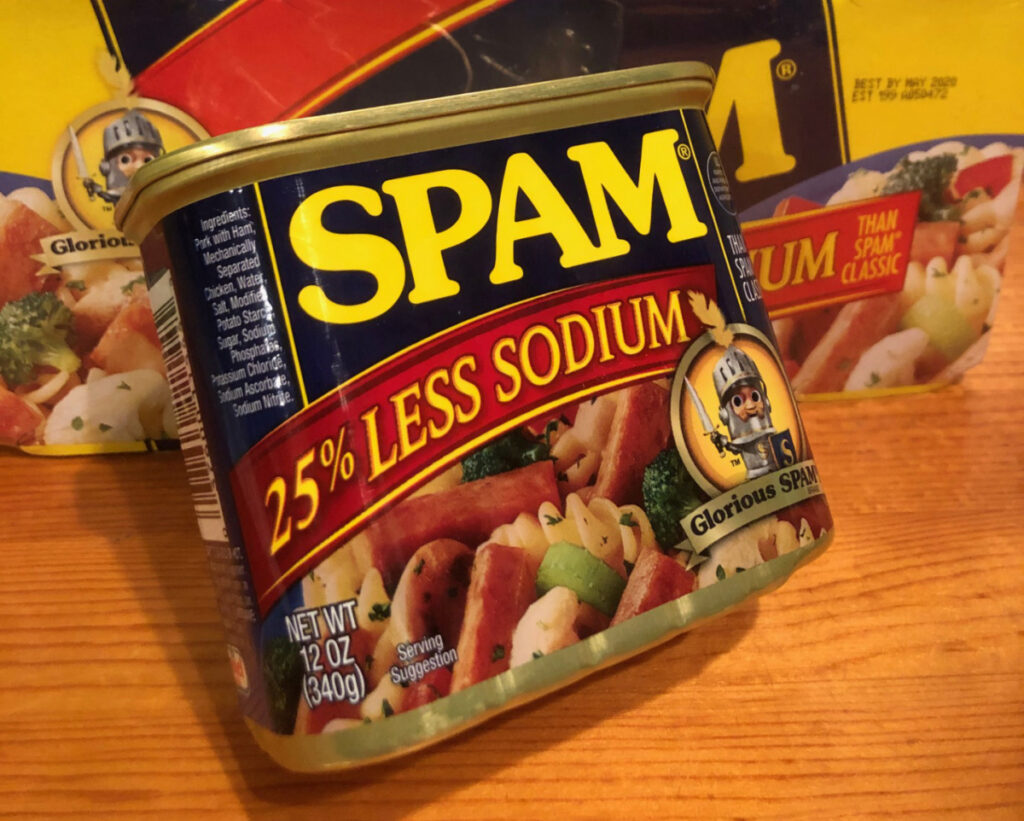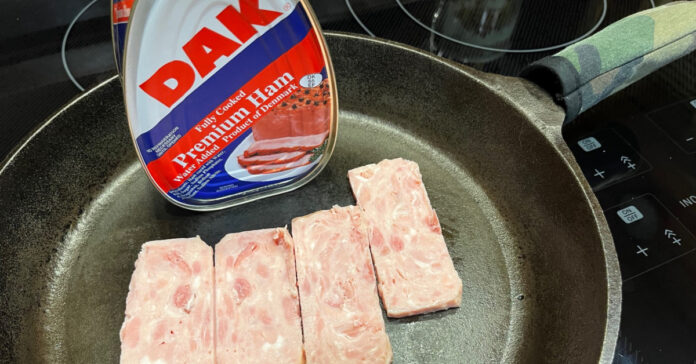I like Spam, and as part of our pantry rotation, I eat a can of it every month. My wife refuses to eat it. She doesn’t even like the smell of it when I cook it. It reminds me of childhood camping trips when we would fry up some Spam over a campfire.
I ate canned ham as a kid, but I haven’t eaten it for 40 years. Because I have two brands of canned ham in my prepper pantry, I decided I had better try it to see if it’s something we will eat and how it compares to Spam.
Canned Ham Feedback
Opening the 16-ounce DAK canned ham was tougher than opening a can of Spam. The can seemed thicker and more robust, meaning the ham might be a better option than Spam if you are going to be subjecting it to some bumps. Canned foods with the easy-opening pull-tab top are nice because they don’t require a can opener, but the top sometimes fails and opens prematurely. This does not happen often, but it’s something you should be aware of.
My initial impression of the ham made me think of chicken loaf; both are small pieces of meat compressed into a larger shape. Granted, Spam is also, but the canned ham was made up of larger chunks. Spam is ground or minced more finely and has a smoother texture.
After slicing a few pieces of ham to fry, it became obvious that the Spam has a higher fat content. When I fry a slice of Spam, I don’t need to oil the pan. The ham didn’t generate any oil, so after that first time, I oiled the pan and it fried up without sticking. Looking at the label, a two-ounce serving of Spam has 16 grams of fat and 180 calories. In comparison, a two-ounce serving of canned ham had only seven grams of fat and just 100 calories. (The fat gives Spam more calories per serving.) The spam had seven grams of protein while the ham had nine.
From my wife’s perspective, the smell of frying canned ham was no better than the small of cooking Spam.
Taste Test
While I wouldn’t call the taste of canned ham enjoyable, it was quite edible. I’m happy to have it in my prepper pantry, but no one is going to confuse it with a Christmas ham or a spiral cut ham. Canned ham might work to make ham salad, however. I can also see using canned ham inside an omelet or to flavor split-pea soup. In a survival situation, you could use pieces of it on a pizza or to add to fried rice in the absence of other meats. This would allow you to stretch a can of ham over several meals.
If given a choice between Spam and canned ham, I would choose to eat the Spam. That’s just my opinion. I am sure some feel the other way.
For Preppers
I am a proponent of having canned meat in your prepper pantry, and right now I have eight times as much Spam as I do canned ham. After tasting the ham, I will get more because variety is important. Here are my thoughts on the advantages and disadvantages of each from a prepping perspective.
Cost: On Walmart.com, Spam is selling for 27 cents per ounce. The ham normally sells for the same cost-per ounce, but as I write this, the Bristol brand is on sale for 24 cents per pound ($3.88 per can).
Calories: While the price-per-pound is the same, Spam is cheaper per calorie. If you want to store fat, protein and calories, it’s hard to beat Spam.
Size: The canned ham is 16 ounces while Spam comes in a 12-ounce can. Whether this makes a difference to you may depend on how many people are in your party and whether you can store leftovers without fear of spoilage.
Sodium: If you are worried about your sodium intake and high blood pressure, neither of these is a great choice. The ham, however, has about 20 percent less sodium per serving. There is a version of Spam with 25 percent less sodium, and it has even less sodium than the ham.

Flavors: As a child, we only ate what is now called “classic” Spam. It comes in multiple flavors now. I have some bacon-flavored Spam in my stash, and I have seen maple Spam and hickory smoked Spam in stores. If you search online, you can find jalapeno Spam, hot and spicy Spam, Spam made with Portuguese sausage seasoning, and other varieties. So if you are looking to spice up your canned meat storage, Spam offers variety.
Compared to Corn Beef
I have a few cans of corned beef in my prepper pantry, but these fall well down the list or my favorite canned meats. The corned beef just doesn’t cut it for me. I have heard that the Walmart version of canned luncheon meat compares favorably with Spam at a lower price, but I haven’t tried it myself.
Mell Tappan, an early prepper author, and Jeff Cooper, a pre-eminent firearms trainer and the father of modern combat shooting, predicted than .22LR ammo would become “ballistic wampum,” or a de facto currency after the SHTF. I expect a can of Spam will also have tremendous value under similar circumstances. I have a hard time seeing myself trading away ammo or food unless I am desperate for something like a life-saving medicine, a few gallons of gasoline, or a critical machine part.
Of course, the value of a box of ammo is that you can break it down and trade five or ten rounds. Hard to do that with a can of Spam. Plus, while Spam lasts a good long time, ammo has a longer shelf life.
Both canned ham and Spam get a check mark on my list of canned meats, but canned chicken takes the top spot, followed by chili. I recommend you store as many varieties of canned meat as possible for the coming bad times.







